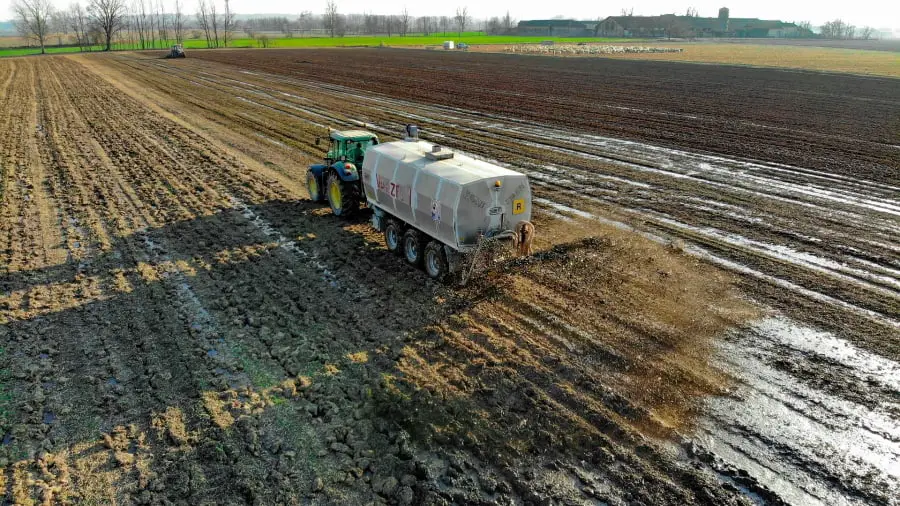Fertilizer is one of the best ways to give your grass, plants, or crops a well-needed boost for maximum health. Both organic and processed fertilizers give us a great number of soil-boosting options. However, choosing a type of fertilizer is not the same as using it correctly.
Granular and other dry fertilizers should be dissolved in water in order for the nutrients and other desired elements to get to the roots of the plants. These need the aide of water to reach the plant and in many cases to get them into a state that plants can absorb.
Today I am firmly focused on correct usage. Join me as I discuss whether mixing fertilizer and water is a good idea. I will dive into the details of what happens when the two come into contact. You will also learn the best way to mix fertilizer so your plants have everything they need to reach their full potential!

Contents
What Happens When You Put Fertilizer In Water?
When water and fertilizer are mixed, one of two things can happen. Either some (or all) of the fertilizer gets dissolved or the fertilizer remains in undissolved form. This depends on the type of fertilizer and what it was designed to do in wet or saturated situations.
Of course, it is not quite that simple. Several factors can affect how a particular fertilizer will react to exposure to water. For this article, I will assume the water is distilled, free from contaminants, and only mixed with one fertilizer.
If you are looking for the easiest granule fertilizer for your lawn, we always recommend Scotts Turf Builder (It is one of the most popular for good reason at this link to Amazon). It is designed with the novice in mind with great instructions and easy application. Just spread evenly and you are good to go without worries of ‘burning’ or otherwise damaging your lawn.
There are also inexpensive spreaders that even professional lawn crews use to ensure no concentrated spots are created in the grass surface. Here is a good, cost effective spreader from Amazon that I recommend.
Solubility Of The Fertilizer
The first and most important factor is the solubility of the fertilizer in question. There are soluble and insoluble fertilizers. The latter group includes organic fertilizers like fish meal and bone meal that cannot be broken down by exposure to water. You also have inorganic fertilizers with non-soluble components.
Non-Soluble Fertilizers
The nutrient content in non-soluble fertilizers can only be absorbed by plants after they have been broken down by soil microbes. These are the bacteria, fungi, worms, and any other organisms that help accelerate the decomposition of matter. Fish meal, for example, can only be absorbed once microbes break it down to amino acids.
Yet, make no mistake, eventually the goal is for it to become soluble and transportable by water. It just needs an extra step in the process.
Soluble Fertilizers
Soluble fertilizers, on the other hand, will break down when they are exposed to water. However, this does not mean that haphazard mixtures of water and a “soluble” fertilizer will result in a complete solution. You will need to polish up your math skills if a 100% fertilizer solution is your aim. Failure to measure may result in unwanted sedimentation.
Other Factors Affecting Fertilizer Solubility
Luckily, if you use a store-bought fertilizer, the packaging will likely have a solubility chart on the back of the package. These charts often indicate the solubility of the fertilizer’s components in a given volume of water (ounces of fertilizer component per liquid gallon). Some brands use grams per liter (g/l) instead of oz/gal.
Water Temperature Affects Fertilizer Solubility
Water temperature also has a pivotal role in the solubility of fertilizer. Typically, the higher the temperature, the higher a fertilizer’s (or fertilizer component’s) oz/gal value. Some components (i.e., calcium nitrate) will dissolve completely at lower temperatures than others (i.e., potassium nitrate).
If you plan on using a fertilizer with multiple compounds that have a particular element in common (usually nitrogen or potassium), quantities of those elements may not dissolve due to oversaturation. This means you will have to add more water or raise the water temperature if you want a 100% solution.
Remember, the math involved above assumes the use of pure distilled H2O. In the real world, you will probably use tap or mineral water which is either treated with chemicals (chlorine or fluorine) or rich in minerals (calcium, magnesium). This changes the chemical landscape and, ultimately, the fertilizer’s solubility.
If you would like to see other articles like this one, then take at some of my others here…
- A Gasoline Spill On Grass And Lawns – How To Fix It
- Will Bleach Kill Grass And Weeds In Your Lawn And Walkways?
- Will Grass Spread To Bare Spots?
Can You Change Granular To Liquid Fertilizer?

Fertilizer is often made in the form of pellets that we refer to as “granular fertilizer” because it is easier to store in this form. Granular fertilizers also last much longer than their liquid counterparts.
You can change granular to liquid fertilizer with the proper type of water, the proper ratio, and enough time. Distilled water is necessary for the process and at least 24 hours of time needs to be available in order for granules to completely dissolve.
Let’s not forget that, on average, granular fertilizers are cheaper.
That is not to say liquid fertilizers do not have their perks too. In liquid form, the fertilizer can be distributed more evenly. Liquid fertilizer also allows the fluid movement of “immobile” nutrients to the roots, where they can be easily absorbed by plants.
DIY Granular To Liquid Fertilizer Conversion
If you want the best of both worlds, you are in luck. A DIY conversion of granular to liquid is very possible. In fact, it is a relatively simple process. Please note that the conversion only works one way. You cannot turn liquid fertilizer into granules.
Distilled Water
The first step is to place the granules in a container with distilled water. Remember what we said about treated and mineral-rich water? Anything other than pure water will make it difficult for the granules to dissolve.
Time
The mixture should be equal parts granules and water (1:1 ratio), with minor adjustments made according to the fertilizer solubility chart. Once you’ve found a suitable ratio (it doesn’t need to be perfect), leave the mixture for 24 hours.
Distribute
Once the 24 hours are up, you should stir the mixture to distribute the fertilizer properly. Some granules will still be intact, which is fine. Use a strainer to separate the solution from the undissolved granules.
You can then store the liquid fertilizer in a cool dry room in a sealed container. Make sure the room is dark to avoid stimulating further reactions. The undissolved granules can still be used as fertilizer.
Why Is Fertilizer Soluble?
Some newer to fertilizers may not know that granular fertilizers are in a dry state for storage and transportation purposes. So, does this mean that all fertilizers are soluble?
All fertilizers should be soluble in water because that is the only way they can be absorbed by plants. Even the so-called “insoluble” fertilizers are eventually broken down into components that can dissolve in water. In order to help the plants they are designed for, fertilizer must dissolve.
We also touched on immobile nutrients earlier. Water is almost like a mode of transport for essential elements like phosphorous, which would not be able to even reach the roots without water.
If after spreading fertilizer on any area, you find granules after several days, make sure you have followed directions for application properly and applied the recommended amount of water. If relying on rain to dissolve the granules, make sure area have not been shaded from moisture and that the proper amount of rainfall has occurred.
How To Mix Fertilizer?
What’s better than one fertilizer? Multiple fertilizers!
Or so one would think…
While this train of thought is understandable, the process of mixing fertilizer cannot be approached haphazardly.
1. Understand Fertilizer Compatibility
The first thing you need to understand before you start mixing fertilizers is the issue of compatibility. Some fertilizers do not mix. Examples include calcium and its compounds, which should never be mixed with phosphorous or sulfur compounds.
Mixing compounds with a common element should also be avoided because it will result in reduced solubility. This sedimentation could prove especially costly if the fertilizer will be deployed via a drip irrigation apparatus.
2. Understand Your Soil
The second thing you need to know is your soil’s nutritional content. Remember, fertilizer supplements the soil to ensure it has all essential nutrients. Pay particular attention to the nitrogen, phosphorous, and potassium content (NPK) as these are the most essential elements to plants.
Create your mixture based on what your soil already has or what it lacks. If, for instance, your soil is already rich in phosphorous (P), there is little need to create a mixture with a high percentage of phosphorous.
In theory, mixing fertilizer should be based on mathematical calculations. However, most folks will probably opt for trial and error. Try implementing a bit of both so you can make minor tweaks along the way.
The Final Touches On Dissolving Fertilizer In Water…
Now we can see that not only can you dissolve dry fertilizer in water, it is actually a necessary process. You can even turn dry fertilizer into liquid fertilizer if you have the proper storage container and space.
Plants can be helped quite a bit from using the proper fertilizer, but can’t reap any of the benefits if it is not properly transportable by water.
On the flip side, the over use or improper mixtures of fertilizer can in effect ‘burn’ your plants and do way more harm than good. Make sure to use recommendations from manufactures and proper amounts.
Looking for more information on helping plants grow? Then I recommend some of my other articles here…
- A Gasoline Spill On Grass And Lawns – How To Fix It
- Will Bleach Kill Grass And Weeds In Your Lawn And Walkways?
- Will Grass Spread To Bare Spots?
References
https://crateandbasket.com/turn-granular-fertilizer-into-liquid/
https://gardeningmentor.com/can-you-dissolve-granular-fertilizer-in-water/
https://www.smart-fertilizer.com/articles/fertilizer-solubility/

